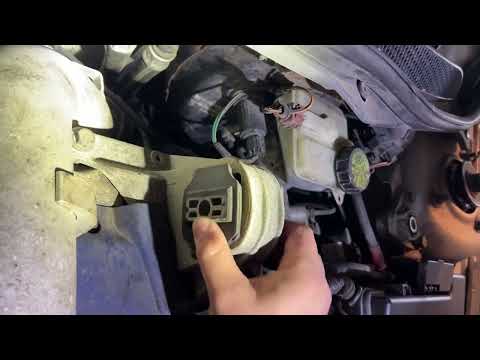If only all repairs could be this simple yet rewarding.

My daily-driver 2005 Volvo V70 R has been dependable, despite its 185,000-mile odometer reading and age. It’s never broken down or left me stranded, and outside of oil changes I’ve replaced only brakes, tires, a minor sensor, and the original radiator and air conditioning compressor. This spring, I gave it a little more love to hopefully prolong its life.
Click here to paw through previous entries of our project car diaries.
The most significant issue I’ve faced with my Volvo (so far) was a confounding highway stumble at steady-state cruising. The car eventually threw a code, which I traced to a faulty fuel rail pressure sensor (the V70 R uses a sensor on the fuel rail rather than a fuel pressure regulator). One $50 sensor and an hour later, I was back in business.
The fault code that helped me trace a highway stumble to a faulty fuel rail pressure sensor. The ScanGauge II is an older OBD scanner design, but it integrates nicely with the aesthetic of many pre-2010 cars. Executive Editor Andrew Collins has one hard mounted in his Montero’s dashboard—check it. Maddox Kay
When an unfortunate accident took out my close friend’s E90 BMW, I was happy to let him borrow my trusty wagon for a couple of weeks while he dealt with insurance and figured out a replacement vehicle. I was in California for work and visiting family anyway, and my wonderful fiancee wouldn’t need to move the car for weekly street cleaning. It was a win-win.
I believe in letting trusted friends drive and borrow your project cars as part of the sorting-out process. As you drive something regularly, you get attuned to its flaws and quirks, and a fresh set of eyes can often determine whether that clicking sound or vibration at speed is a mission-critical issue or just an annoyance. But this car is my daily, and, I thought it was sorted.
I thought.
My daily driver V70 R has carried me all over the Northeast for two years and 15,000 miles. Maddox Kay
Signs of Trouble
My friend Ross picked up the car, ironically, from another friend who had borrowed it to transport a large mirror. I didn’t hear anything for a day or two. Then, he reported a cold start misfire that went away after a few seconds. The next day, the car misfired again, going into limp mode as he pulled away from a light. At the advice of your nearest IT professional, he shut the car off and turned it back on, and everything appeared to be normal.
Luckily, Ross is mechanically inclined and owns an OBD-II reader. He pulled the codes: P0301, for a misfire in cylinder one, and P0300, a code for a general or random misfire.
Since the issue was intermittent and seemingly affecting one cylinder more than the others, I suspected the ignition system to be the culprit. Spark plugs and coil packs generally last a while, but I’d never changed them out on this car. I have a parts receipt from the previous owner that includes plugs but not coils, which isn’t unheard of because plugs are cheap and coils are relatively expensive. I ordered a set of each from FCP Euro and told Ross to let me know if the issue came back (it didn’t).
Tune-Up Time
When I returned to New York, we set aside a Sunday afternoon to do the job. Changing spark plugs on a transverse-mounted, inline-engined car is a relatively easy task that I’d recommend anyone interested to try at home. (On the other hand, changing spark plugs on a boxer engine in a dorm parking lot, as I once did, is a task I wouldn’t wish on my worst enemy.) Since you’re poking around the engine, it’s also a good chance to check on your car’s belts, seals, and even inspect for signs of rodent damage.
To change a set of spark plugs in most cars, you need a ratchet handle, a decent extension, a normal socket set, a deeper spark plug socket set, a set of feeler gauges, and a torque wrench. I’d also recommend a set of disposable gloves. As with any repair, there may be make- and model-specific quirks, so I recommend checking out a YouTube video for your specific car ahead of time so you can be prepared for any additional tool requirements.
A spark plug job will make you grateful for a small engine if you’ve got one. Replacing plugs on something like an inline-four Honda can be easier than an oil change, while other cars can require hours of tedium pulling intake manifolds and other things that might be in the way. Front-wheel drive V6 cars and cars with horizontal or “flat” engine layouts such as Subarus and Porsches can be particularly troublesome.
The V70 R is a five-cylinder turbocharged car with a large metal charge pipe across the engine head, blocking access to the top of the engine. First, you must remove a strut brace that connects the two shock towers to the top engine mount. After removing two 18mm nuts and 15mm bolts that secured the strut bar to the towers, we discovered the top engine mount, likely an original part, had disintegrated.

Next, we removed the top of the charge pipe from the manifold, where it was held in place by a V-clamp and a hex screw. We didn’t have a ratcheting hex screwdriver handy, so we busted our fingers on a tiny Allen key. Then, we could finally remove the engine covers and begin the job. The engine covers on the V70 R are secured with Torx fasteners and hide the timing belt, so taking them off presented a good opportunity to inspect the belt. It was changed seven years and 60,000 miles ago, but still appears to be in good condition:
Maddox Kay
I also spotted some mouse poop and a small amount of oil under the engine covers. The latter could result from a leaky valve cover gasket, while the first is an unfortunate consequence of parking an old European car outdoors. I doused both in Brakleen and wiped away with paper towels. I also coated several exposed wires in electrical tape and sprayed them with peppermint oil to hopefully deter enterprising rodents.
Finally, we did the actual job: Changing the spark plugs and coil packs. This was by far the easiest bit—the coil packs were held in by just a single bolt and Weatherpak connector each. I labeled the old coils and we changed one coil and plug set at a time so we wouldn’t lose track of the connectors. The plug electrodes looked to be in decent shape, but the plugs themselves were older-looking. After hand-threading and torquing the new plugs to spec, we installed the new coil packs.
Before putting the car back together, I wanted to see if we could do something about that toasted top mount. After doing some Googling, the local auto-parts chain’s website indicated one in stock, so I zipped over with the borked part in hand to confirm it was the identical piece.
Score! $59 and four bolts later, I had a new engine top mount:
Finally, I reinstalled the engine covers and reattached the charge pipe (installation is the reverse of removal). I fired the wagon up to a nice smooth idle and backed out of the garage. Immediately, the car felt better. It could’ve been the placebo effect, but after seeing the trashed old engine mount, I could hardly believe I’d been driving on it for nearly 15,000 miles.
This was a perfect open-and-shut afternoon repair: I addressed a maintenance item, and in the process, did a routine check-up on my car. I found an additional fault and was able to rectify it quickly, without disrupting the process or keeping the car down for too long. If only all repairs could be this simple yet rewarding.
Then, a week later on the first day warm enough to run the AC, it overheated in stop-and-go traffic. Old cars, am I right?


